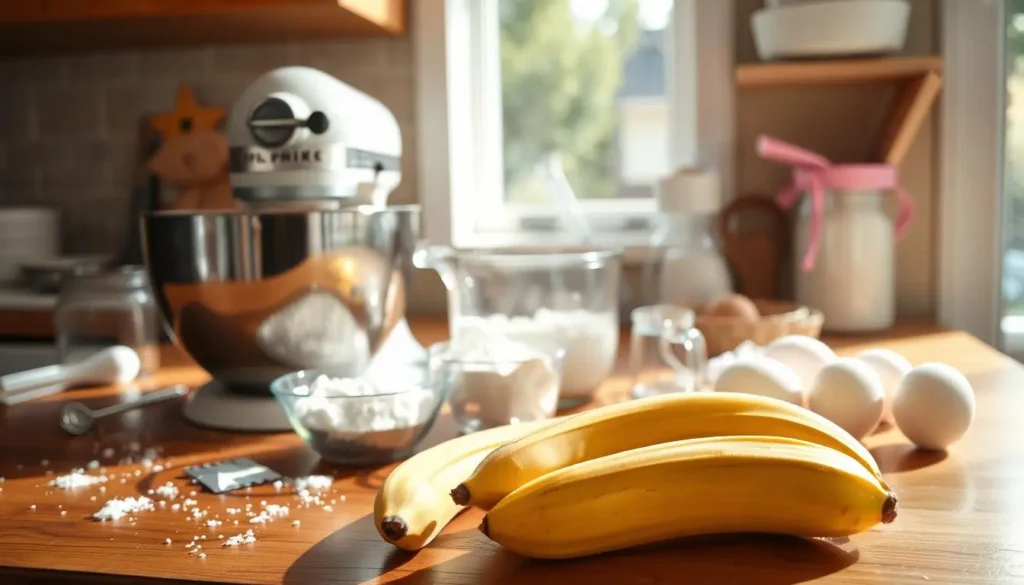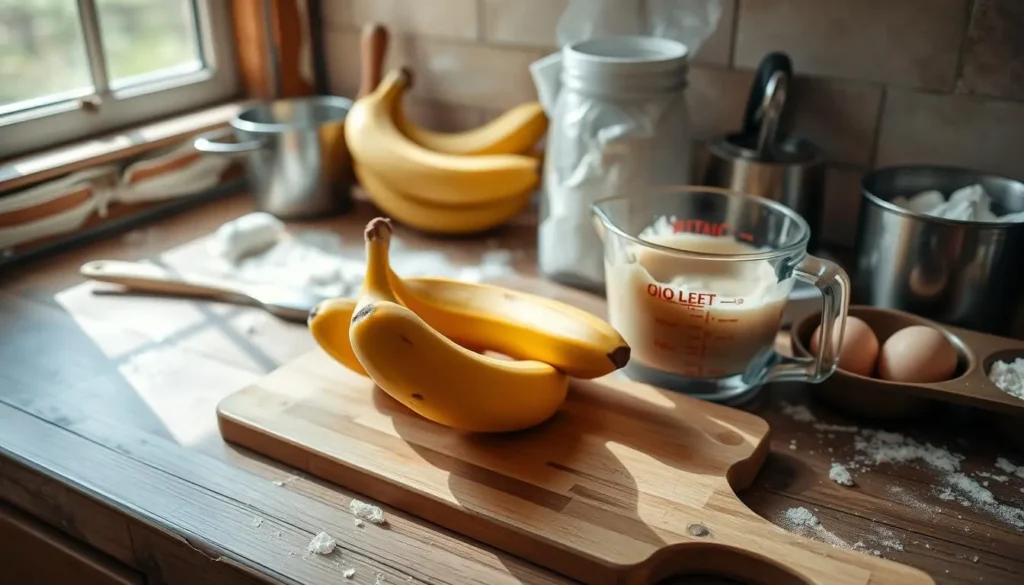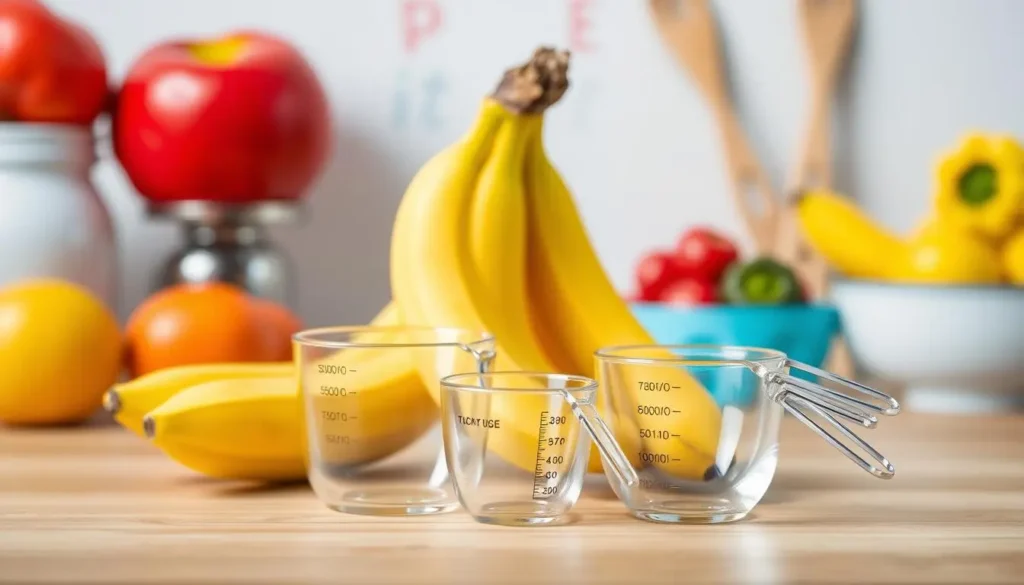When baking banana bread, you often need 2 bananas. But have you ever thought about how many cups that is? Measuring bananas can be tricky because they come in different sizes. To get the best banana bread, you need to measure the bananas correctly.
Knowing how 2 bananas translate to cups is key for a great banana bread. You want your bread to be moist and full of flavor. So, how many cups of banana are in 2 bananas? Let’s explore the world of banana measurements to find out.
Key Takeaways
- Accurate measurements are crucial for a perfect banana bread recipe 2 bananas.
- Banana sizes can vary, making measurements challenging.
- Understanding the equivalent of 2 bananas in cups is essential for the best results.
- A banana bread recipe 2 bananas requires precise measurements for optimal flavor and texture.
- Measuring bananas in cups can be tricky, but it’s necessary for a delicious banana bread recipe 2 bananas.
- Using the right amount of bananas is key to a moist and flavorful banana bread recipe 2 bananas.
- Exploring banana measurements will help you achieve the perfect banana bread recipe 2 bananas.

Understanding Banana Measurements in Baking
In baking, getting the measurements right is key to success. If you’re wondering what to use if you don’t have enough bananas for banana bread, you’re not alone. Knowing how to measure bananas is crucial to solving this problem.
The ripeness of bananas and how you measure them can change the outcome. Ripeness affects the volume of mashed bananas, with riper bananas making more mash. Also, using volume measurements can lead to errors, while weight measurements are more accurate.
Why Precise Measurements Matter
Getting the measurements right is vital in baking. Too little or too much of an ingredient can ruin the texture, flavor, and quality of your baked goods. For banana bread, the right amount of mashed bananas is essential for the perfect consistency and taste.
Different States of Banana Ripeness
Bananas can be green, yellow, or brown, each with its own ripeness level. The ripeness affects the volume of mashed bananas, with riper bananas making more mash. Here are the common ripeness levels:
- Green: firm and starchy
- Yellow: ripe and sweet
- Brown: overripe and soft
Volume vs Weight Measurements
There are two ways to measure bananas: by volume or by weight. Volume measurements use cups or other units, while weight measurements use grams or ounces. Here’s a comparison:
| Method | Description |
|---|---|
| Volume | Measuring bananas in cups or other units of volume |
| Weight | Measuring bananas by weight |
How Many Cups of Banana Are 2 Bananas?
Understanding banana measurement conversions is key for making recipes right. You might wonder how many cups of banana are in 2 bananas. The answer changes based on banana size and ripeness.
A medium banana is about 1/2 cup of mashed banana. So, 2 bananas would be about 1 cup of mashed banana. But, this can change with banana size and ripeness.
Here’s a quick guide for banana measurement conversions:
- 1 small banana = 1/3 cup mashed
- 1 medium banana = 1/2 cup mashed
- 1 large banana = 3/4 cup mashed
Remember, these are just rough estimates. The exact amount can differ based on the bananas you use. For the best results, use a kitchen scale or measuring cups.
Knowing how many cups of banana are in 2 bananas helps you get the right texture and taste in your baked goods. Whether it’s banana bread, muffins, or cakes, getting the measurements right is key.
Factors Affecting Banana Volume Measurements
Measuring bananas for recipes can be tricky. Several factors can change the volume, affecting the final product. Knowing these factors is key to getting consistent results.
The size of bananas can vary a lot. This size difference can greatly affect the volume. Also, how you mash the bananas matters. Over-mashing makes the mixture denser, while under-mashing makes it lighter.
The ripeness of bananas is another key factor. Riper bananas are softer and easier to mash. This can also change the volume.
Some key factors affecting banana measurements include:
- Size variations: Bananas come in different sizes, ranging from small to extra-large.
- Mashing technique: The way you mash the bananas can affect the volume, with over-mashing resulting in a denser mixture.
- Ripeness: The ripeness of the bananas can impact the volume, with riper bananas being softer and more prone to mashing.
By considering these factors, you can adjust your recipe. This helps achieve the right consistency and flavor.
| Factor | Impact on Volume |
|---|---|
| Size | Significant impact, with larger bananas resulting in a greater volume. |
| Mashing Technique | Can result in a denser or lighter mixture, depending on the technique used. |
| Ripeness | Softer, riper bananas are more prone to mashing, resulting in a greater volume. |
Converting Whole Bananas to Mashed Measurements
When converting bananas to cups, it’s key to think about what changes the volume. You can use a few methods to get the right amount for your recipes. Scoop mashed bananas with a measuring cup or weigh them before mashing.

To make converting bananas to cups simpler, here are some tips:
- Use ripe bananas for the best flavor and texture
- Mash the bananas with a fork or potato masher for a chunky texture
- Use an electric mixer for a smoother texture
Here’s a rough guide to help you with converting bananas to cups:
| Number of Bananas | Approximate Volume |
|---|---|
| 1 large banana | 1/2 cup mashed |
| 2 large bananas | 1 cup mashed |
| 3 large bananas | 1 1/2 cups mashed |
By following these tips and using the guide above, you’ll be able to accurately convert whole bananas to mashed measurements. This ensures your baked goods are delicious and moist.
Best Practices for Measuring Bananas in Recipes
When baking with bananas, getting it right is crucial. To get the best results, follow these tips for measuring bananas. Use the right tools, techniques, and store bananas properly to keep them fresh.
Measuring bananas can be tricky, but with the right steps, you can get consistent results. The ripeness of your bananas is key. As they ripen, they get softer and sweeter, changing the taste and texture of your baked goods.
Tools for Accurate Measurement
To measure bananas accurately, you’ll need a few basic tools. You’ll need a digital kitchen scale, a measuring cup, and a masher or fork. A banana slicer can also help you get even slices.
Mashing Methods
There are many ways to mash bananas, depending on what you need. You can use a fork for a light mash or a masher for a smoother texture. Some recipes might ask for pureed bananas, which you can make with a blender or food processor.
Storage Tips
To keep bananas fresh, store them right. Keep them at room temperature, away from sunlight, and don’t wash them until you’re ready to use them. You can also store them in the fridge to make them last longer.
By following these tips, your baked goods will be light, fluffy, and full of flavor. Whether it’s a simple banana bread or a complex dessert, accurate measurement is key to success.
Adjusting Recipes When You’re Short on Bananas
Running out of bananas while baking can be a bummer. But, there are ways to make do with less. You can scale down the recipe or swap bananas with other ingredients.
Try mixing mashed and sliced bananas for a good texture and taste with less fruit. Another approach is to add moisteners like applesauce or yogurt to replace bananas.
- Reduce the recipe quantity: If you only have one or two bananas, consider making a smaller batch of your recipe.
- Substitute with other ingredients: Applesauce, yogurt, or other fruits can add moisture and flavor to your recipe.
- Use a combination of mashed and sliced bananas: This can help you achieve the desired texture with fewer bananas.
By adjusting recipes for fewer bananas, you can still enjoy your favorite treats. A bit of creativity and experimentation can solve your banana shortage.
Remember, the key to successfully adjusting recipes is to experiment and find the right balance of ingredients. Don’t be afraid to try new combinations and flavors – you might just discover a new favorite recipe.
| Ingredient | Substitution |
|---|---|
| Bananas | Applesauce, yogurt, or other fruits |
| Mashed bananas | Sliced bananas or other moist ingredients |
The Role of Bananas in Baking
Bananas are key in baking, adding texture, flavor, and structure to treats. They play a big role in several areas.
Moisture Content
Bananas make baked goods tender and fresh. They add moisture, which is crucial when dry ingredients are used.
Natural Sweetness
Bananas are sweet, so you need less sugar in recipes. This is great for those who watch their sugar intake.
Binding Properties
The pectin and starch in bananas help mix ingredients. This is helpful when you don’t use eggs or other binders.
Understanding bananas’ role in baking opens up new possibilities. They make treats like banana bread and muffins extra special.
| Benefit | Description |
|---|---|
| Moisture Content | Adds natural moisture to baked goods |
| Natural Sweetness | Rich source of natural sweetness, reducing need for refined sugars |
| Binding Properties | Helps bind ingredients together, creating a cohesive texture |
Choosing the Right Oil for Banana Bread
When baking banana bread, you want it to be moist, flavorful, and top-notch. The type of oil used is key. So, what is the best oil to use when making banana bread? Let’s look at the pros and cons of different oils and how they affect banana bread.
A great oil for banana bread should boost the flavor and texture without taking over. Popular choices include canola oil, coconut oil, and olive oil. Each has its own flavor, smoke point, and nutritional benefits. For instance, canola oil has a neutral taste and a high smoke point, making it perfect for baking.
Here are some key things to think about when picking an oil for your banana bread:
Choosing the Right Oil for Banana Bread
- Flavor profile: Pick an oil that goes well with bananas’ natural sweetness, like canola or coconut oil.
- Smoke point: Choose an oil with a high smoke point to avoid burning or smoking during baking.
- Moisture content: Opt for an oil that keeps the bread moist, such as olive or avocado oil.
By considering these points and picking the right oil, you can make a delicious, moist banana bread. So, what is the best oil to use when making banana bread? It really depends on what you like and your recipe. But with some trial and error, you’ll find the perfect oil to make your banana bread amazing.
Common Banana Bread Mistakes to Avoid
Making banana bread can be tricky. Common mistakes can ruin your loaf. Let’s look at these errors to help you make the perfect banana bread. One big mistake is getting the measurements wrong. This can make your bread too dense or dry.
Another mistake is how you mix the ingredients. Mixing too much can make your bread tough. Mixing too little can leave it not fully combined. Temperature issues also matter a lot. If your oven is off, it can change your bread’s texture and feel.
Here are some common mistakes to watch out for when making banana bread:
- Using unripe bananas, which can affect the bread’s sweetness and texture
- Not adjusting the recipe according to the number of bananas used
- Overbaking or underbaking the bread, which can result in a dry or soggy texture
To avoid these mistakes, stick to a reliable recipe. Make sure to measure your ingredients carefully. By being careful, you can make a delicious, moist banana bread for any time.
| Mistake | Effect on Bread |
|---|---|
| Measurement Errors | Imbalance of ingredients, dense or dry bread |
| Mixing Problems | Tough or undermixed bread |
| Temperature Issues | Affects bread texture and consistency |
Banana Substitutions in Baking
Bananas are special in baking, but sometimes you might need to find banana substitutions in recipes. This could be because of dietary needs, personal taste, or wanting to try new flavors. Knowing how bananas work in your recipe and finding good substitutes is key.
Common banana substitutions in recipes include applesauce, mashed avocados, and silken tofu. They can replace bananas’ moisture and binding abilities, changing your dish’s taste. For example, applesauce makes things sweeter and softer. Mashed avocados add a creamy, nutty taste.
Here are some banana substitutions in recipes to try:
- Applesauce: Use 1/4 cup of applesauce for one mashed banana.
- Mashed avocados: Swap one mashed banana for 1/2 avocado.
- Silken tofu: Replace one mashed banana with 1/4 cup of silken tofu (blended until smooth).
When using banana substitutions in recipes, you might need to tweak the liquid or spices. This ensures your dish turns out right. Think about how the substitute will mix with other ingredients in your recipe.

Tips for Perfect Banana Bread Every Time
To make perfect banana bread, following some key tips is crucial. One important step is preparing your ingredients. Using room temperature ingredients helps create a smooth texture.
When mixing, avoid overmixing to prevent a dense loaf. Gently fold wet and dry ingredients together. This keeps the bananas’ natural sweetness and moisture, making the bread tender.
Optimal Baking Conditions
Baking time and temperature are also key. Bake at 350°F (180°C) for 55-60 minutes, or until a toothpick comes out clean. The exact time may vary based on your recipe and oven. Choosing the right flour, like all-purpose or bread flour, also impacts the loaf’s texture.
Additional Tips
- Use ripe bananas for the best flavor and texture.
- Don’t overmix the batter, as this can lead to a tough loaf.
- Use the right type of flour, such as all-purpose or bread flour.
By following these tips, you’ll make a delicious, moist banana bread. Always use fresh, high-quality ingredients. Pay close attention to ingredient temperature and mixing techniques.
| Ingredient | Quantity | Importance |
|---|---|---|
| Bananas | 3-4 | High |
| Flour | 2 cups | Medium |
| Sugar | 1 cup | Low |
Conclusion
Measuring bananas correctly is key for great baking results. Knowing how ripeness and mashing affect volume helps. This ensures your banana bread and muffins are always a hit.
Follow the guide’s best practices for measuring and mashing. These tips will help you use bananas in your baking smoothly. You’ll avoid mistakes that can ruin your creations.
Next time you grab those ripe bananas, you’ll know how to use them right. By applying what you’ve learned, your banana treats will be moist, tasty, and beautiful. Your family and friends will love them.
FAQ
How many cups of banana are equivalent to 2 bananas?
On average, 2 medium bananas are about 1 cup of mashed banana. But, the exact amount can change based on banana size and ripeness.
What can I use if I don’t have enough bananas for a banana bread recipe?
If you’re short on bananas, you can use other fruits like applesauce, pumpkin, or mashed sweet potato. Remember, the taste and texture might not be exactly the same as the original recipe.
What is the number one mistake made when making banana bread?
The biggest mistake is not measuring bananas correctly. Wrong measurements can mess up the balance of wet and dry ingredients. This can make the bread too dense or dry.
What is the best oil to use when making banana bread?
For banana bread, use a neutral oil like vegetable, canola, or sunflower oil. These oils won’t clash with the banana flavor. They help keep the bread moist and soft.

